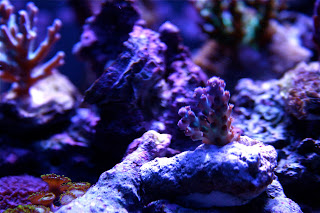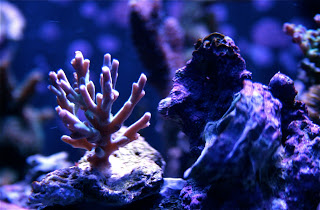Recently the system has been experiencing problems in the rear filtration chambers. Currently there is a unit of Chemi-pure Elite sitting on the bottom of the tank. Not only is it quite likely that not much flow is actually running through the media, rendering it's duties almost useless, but also the bag often gets sucked into the gap between the middle and return sections. This creates a jam clogging the flow and ultimately creating larger problems. Detritus gathers possibly leading to nitrates, water begins flowing up and over the dividing walls and the return pump sometimes blows air because water is not entering the last chamber fast enough. With the media at the bottom of the middle chamber it is impossible to switch out the media or clean it without disturbing the entire the refugium.
A simple DIY solution is the answer. To fix this problem a media rack will be built to create a waterfall effect when the water enters the middle chamber.
Step One: Gather Tools. Some wire cutters, Scissors, Plyers, Lots of eggcrate, a tape measure, and nylon strips are all needed.
Step Two: Measure and Cut the Eggcrate. 4 total pieces are needed to be cut. Find out the width, height and length dimensions of your middle chamber and cut the pieces accordingly. You will be cutting pieces to cover the narrow side and bottom of the rectangular space

Each cube brand and volume is different so I will not post specific measurements to avoid confusion. The goal is to create an "L" shaped rack that is slightly smaller than the space, which will sit where the bio-balls used to sit in the middle chamber.

Step Three: Strap it Together. Nylon strips were used for a quick and easy way to assemble the rack, however epoxy or marine safe glue would also work just fine. When you have the correct width and height for the bottom and vertical pieces connect them with the strips.
Your rack is beginning to take shape. Make sure your vertical eggcrate pieces are about one square skinnier than the bottom piece. Because of the lip on the backside of Nano/Bio Cubes you will need to tilt the rack to get it in.

A square "ladder portion" was added to the build in order to have the media sit higher in the rack. This also allows for stacking media and it also makes the rack stable. This ladder portion is a square with all sides equalling the width of the vertical portion.
As the second vertical piece is attached you create an "H" shape within your "L". With this step the rack is basically complete. While making sure the nylon strips are tight you can trim the tabs off and your eggcrate creation should look something like this...
The bottom of the rack should be a little less than the and length and width of your middle chamber while the height should be equal to the distance from the old false bottom t0 the top of the dividers.

Step 4: Insert the Rack and Media. Gently insert the rack into the middle chamber of your aquarium. Chances are you will have to wiggle it a bit to get past the lips and ridges that were used to hold the stock filtration in place. Hopefully you measured carefully because if you did not you will certainly find out now.

The rack should sit comfortably on the two ridges near the bottom of the chamber leaving a gap between the bottom of the tank and the bottom of the rack. (This is where the bio-ball drip tray used to sit when you bought the tank.) Once the rack is all the way in it should fit nicely in the middle chamber. Now the media is ready to be placed.

This method basically divides your middle chamber allowing chemipure, phosban, and/or carbon to be run in a bags while still leaving enough space to house cheato. As the water leaves your display it creates a tiny waterfall into the middle chamber and now that waterfall flows directly through whatever media you choose to run. Even more importantly the current created by the waterfall effect is absorbed by the media bag allowing your cheato and Fuge dwellers the calm low flow needed for refugium conditions.
Obviously reactors and mechanical filters are the more direct way to force water through a desired media, but in a small aquarium where pumps and heat are always concerns, this is a natural way to direct flow without spending much money or adding electricity into the mix.
-A.




 - A.
- A.








 A Eco-Tech Vortech MP10 wavemaker was recently added to the aquarium. This anticipated addition comes in an exquisite package including all the parts you need to convert your water motion setup into a lifelike ecosystem.
A Eco-Tech Vortech MP10 wavemaker was recently added to the aquarium. This anticipated addition comes in an exquisite package including all the parts you need to convert your water motion setup into a lifelike ecosystem.


















 fully submerging entirely in the solution. Set a timer for 20 minutes and wait. During the 20 minutes periodically rinse the corals with the baster which will blow off any bacteria, parasites, bugs, hitchhikers, etc.
fully submerging entirely in the solution. Set a timer for 20 minutes and wait. During the 20 minutes periodically rinse the corals with the baster which will blow off any bacteria, parasites, bugs, hitchhikers, etc. 